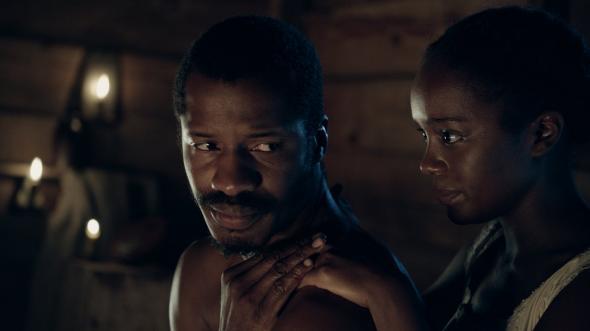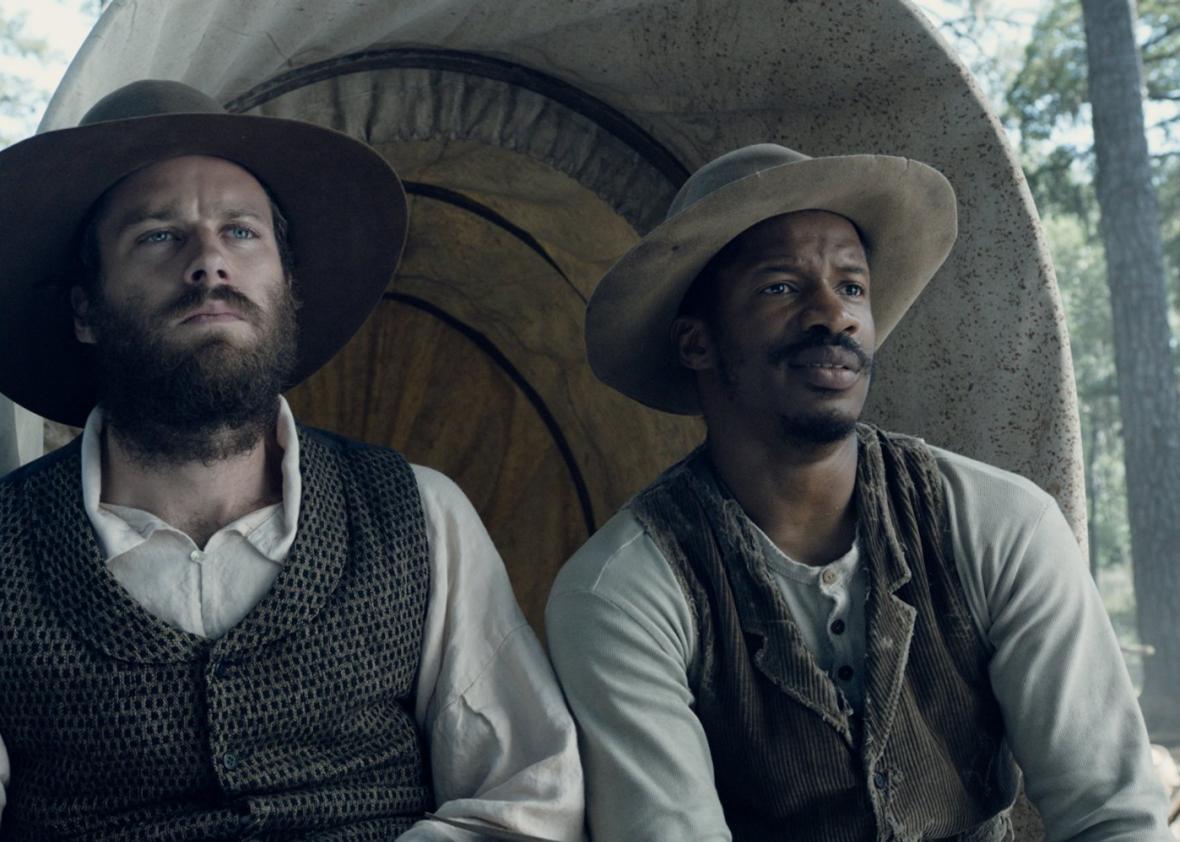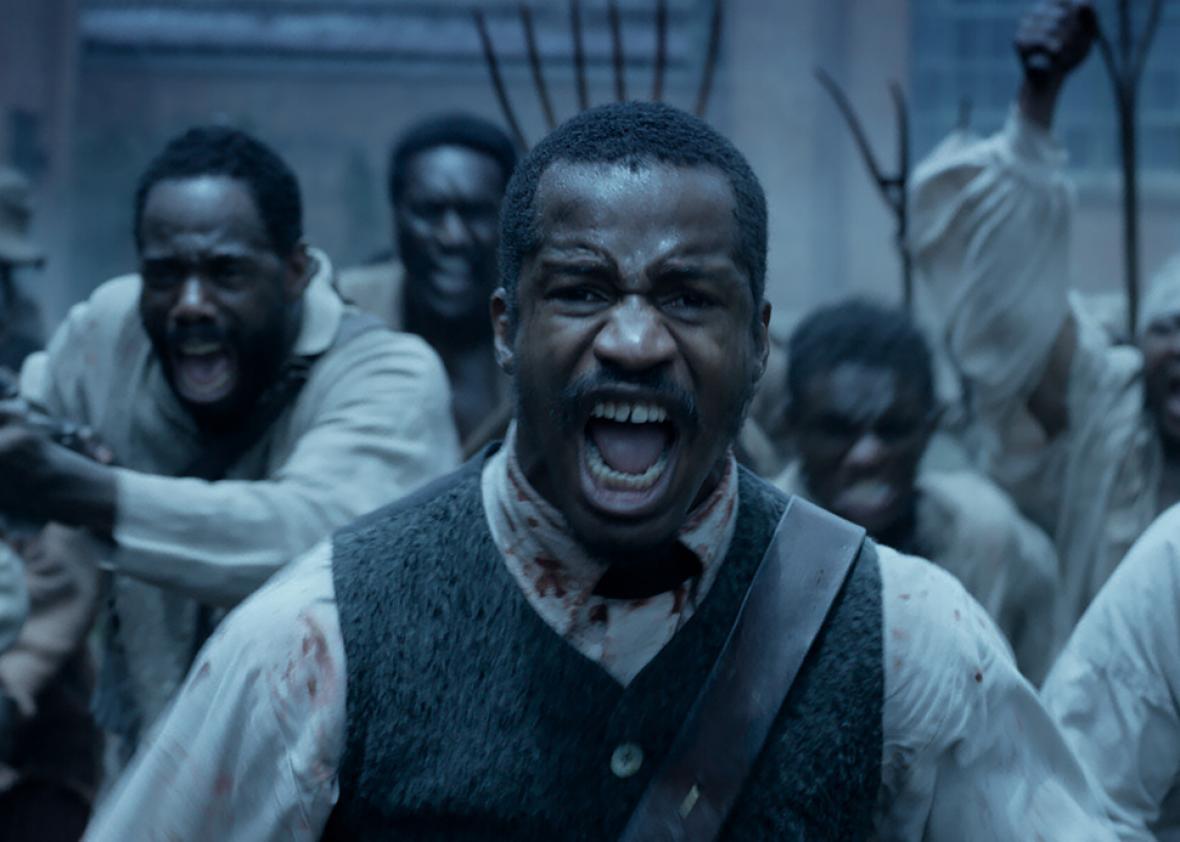Nate Parker’s Nat Turner biopic The Birth of a Nation takes a fascinatingly complicated history and simplifies it into the story of one man’s heroic journey. Which aspects of the film are faithful to the historical accounts of Turner’s slave rebellion, and which take artistic license to invent or elide key events? I read historian Patrick Breen’s 2016 book The Land Shall Be Deluged with Blood: A New History of the Nat Turner Revolt, and consulted with a variety of other sources, to find out.
The role of women in the rebellion

Fox Searchlight
This is the area of history-to-film translation that’s received the most pushback—which is, perhaps, not surprising, given the recently resurfaced rape allegations against the film’s writer, director, and star.
There’s some evidence that Nat Turner’s wife was actually raped before the uprising, but neither that incident, nor the rape of another woman on the Turner plantation, seem to have precipitated the historical rebellion, as they do in the film. Rather, Turner’s revolt was a long time coming and based in his evolving religious beliefs. “By all accounts, Turner took up arms against slavery because he believed slavery was morally wrong and violated the law of God,” historian Leslie M. Alexander writes in her pan of the movie in the Nation. “According to the historical record, these were the only inspirations for Turner’s rebellion. This fact is important because it demonstrates that black people not only fought against slavery because of its extreme violence and brutality but also because they knew in their hearts that slavery was an unjust, exploitative system that violated moral laws.” In reframing the rebellion, Parker and his co-writer (and co-defendant) Jean Celestin have given Nat and his brother-in-arms Hark, whose wife is also raped, a stronger immediate impetus for resistance, while distorting some of the larger meaning of the story.
As more than one critic has joined Alexander in noting, the screenwriters’ enlistment of two rapes as impetus for male action places the women in the film in an unpleasantly subservient position—acted upon, in the sexual violation, then acted for, when the men rise up to defend them. In the real-life fallout from the uprising, one woman, named Lucy, was executed among the rebels, but Lucy is absent from the movie. Many more women would have helped the rebellion along in countless ways, and their actions also remain invisible in Parker’s retelling. (For more on women’s role in this rebellion, and on women’s everyday resistance to slavery in general, read Slate’s interview with historian Vanessa Holden, the author of a forthcoming book on the subject.)
Nat Turner’s religion

Fox Searchlight
In the film, Nat’s slaveholder Samuel Turner earns money from Nat’s nascent talent at preaching, driving him around Southampton County and renting his services to slaveholders who seek the calming influence that lessons from particular parts of the Bible (including the notorious lines enjoining servants to obey their masters, from the Gospel of Luke) can provide. Nat, pressed into action, preaches subservience even with growing doubt in his heart, because the white owners are watching.
The historical record depicts a Nat whose religious views on slavery evolved even more drastically over time. In Breen’s history of the Turner revolt, he recounts evidence that Nat ran away from slavery in 1825, only to come back to his plantation after he felt he heard a message from the Holy Spirit telling him to think of his reward in Heaven, instead of his earthly station. The preachings the fictional Nat issues under duress appear, in the historical record, to have been Nat’s actual thoughts and beliefs in the half-decade before the revolt. Perhaps because of this, Turner had very few disciples among his fellow slaves until he began preaching with what Breen calls “a growing radicalism,” which began to rise in him starting around 1828.
Samuel Turner (Armie Hammer)

Fox Searchlight
Unlike the film’s Nat, the historical Nat had not grown up alongside the slaveholder he attacked on the first night of the revolt. That relationship is another invention meant to raise the stakes of the rebellion. Nat was sold several times in his life; while he may have learned to read alongside a slaveholder’s child in his youth, at the time of the rebellion, he was owned by another man named Joseph Travis.
Nate Parker’s Nat is unflinchingly violent, dealing a righteous blow to his former playmate and current slaveholder, among many others. Breen writes that the historical Nat, however, killed fewer white people than his fellow rebels—he failed, on a few occasions, to fully kill those he attacked and left it to a co-conspirator named Will to deal the final blow. In the end, Nat Turner appears to have been fully responsible for the death of only one person—a woman, Margaret Whitehead. It’s not clear why this was the case, but it certainly wouldn’t have helped the heroism of Nate Parker’s fictional Nat to show these failures.
The violence of the revolt
In Virginia in 1831, the rebels killed around 60 men, women, and children, including one infant that the record shows they decapitated and left in a fireplace. The idea was total war. “If the rebels hoped that the killings of whites would win them support from the black community,” Breen writes, “there really was no better opportunity for a dramatic killing than a ‘little infant sleeping in a cradle,’ ” a death that would prove the rebels’ absolute commitment. The film, on the other hand, is at its grisliest when we see one rebel decapitate an adult male slaveholder and hold up the disembodied head. This slaveholder, we saw earlier in the film, was the worst of the lot—and is coded as lower-class white trash, to boot—which makes the gory beheading easier for many viewers to digest.
The film would have been very different if it featured a rebel band that killed infants and children (and drank alcohol between visiting plantations, as Breen reports the group did). If you’re making a movie in the mold of Mel Gibson’s Braveheart, ambiguities like these get in the way of a more simple narrative of a hero’s journey. They might also tempt naysayers determined to apologize for slavery, or to avoid conversations about its legacy, to focus on the brutality of the rebellion, rather than the history of bondage that led to it.
The climactic battle

Fox Searchlight
Perhaps it was Parker’s love for Braveheart, or advice he got from Gibson while preparing to direct the film, that prompted him to add a climax that has Turner and his group of rebels facing white defenders at the armory in Jerusalem, Virginia. The scene provided a perfect “last stand” battle for Parker’s cameras. The historical Turner meant to attack Jerusalem, but in the wake of several skirmishes with white militia and plantation owners defending their homes, he had increasing trouble recruiting more rebels. His cohort was eventually whittled down to a handful. The rebellion dissipated slowly, rather than going down in a single blaze of glory.
The film’s choices are certainly more cinematic, but in Breen’s retelling of the historical Turner’s shifting strategy over the course of the revolt, you get a sense of both the tactical acumen he displayed and the organizational challenges he (or any other leader of a slave rebellion in that part of Virginia in 1831) might have faced.
The rebellion’s aftermath and legacy
The film wraps things up fairly rapidly, with a montage of slaves and free black people being lynched by fearful whites. The retaliatory violence committed against Southampton’s black population in the wake of the rebellion had a lasting effect on the region’s black community. After the revolt, as historian Manisha Sinha told the radio station WBUR, “over 300 [free] African-Americans actually left that area and [fled] to Liberia, fearing for their lives.”
The white community’s response to the revolt was conflicted. Breen argues that the elite group of slaveholders who conducted the trial had a great deal invested in characterizing the revolt as unorganized and ineffective, and in saving the lives of as many slaves as could be saved (thereby keeping the court from having to pay their owners, who would be compensated if they were executed). Meanwhile, frightened poorer white people demanded blood and blamed the slaveholders for not being able to keep order. Neither this class dynamic, nor the story of Nat Turner’s famous Confessions (recorded in his jail cell by local attorney Thomas R. Gray), make it into the movie.
The film’s final shot shows a young boy watching Turner’s hanging, before cutting to show that same boy decades later, fighting for the Union in the Civil War. While there isn’t a direct historical connection between the revolt and the war, historians argue that we should think of black resistance to slavery as one long project. Rebellion manifested through hundreds of years of everyday resistance, occasionally burst forth in violent revolts, and culminated in the actions of those who left plantations and fled to the Union lines during the Civil War, bringing Southern agriculture to a grinding halt while providing firepower and labor to the Army. Birth of a Nation’s last shot is a stunning way to make this connection clear.
